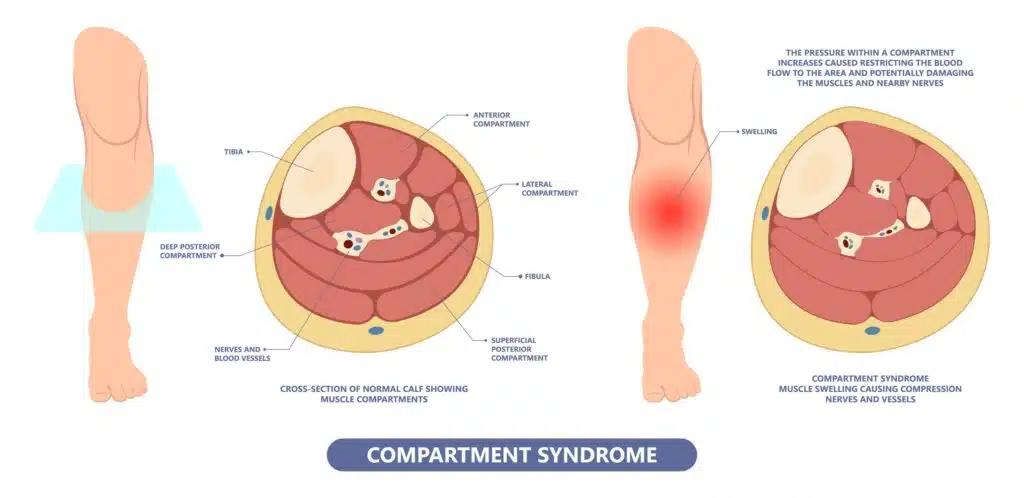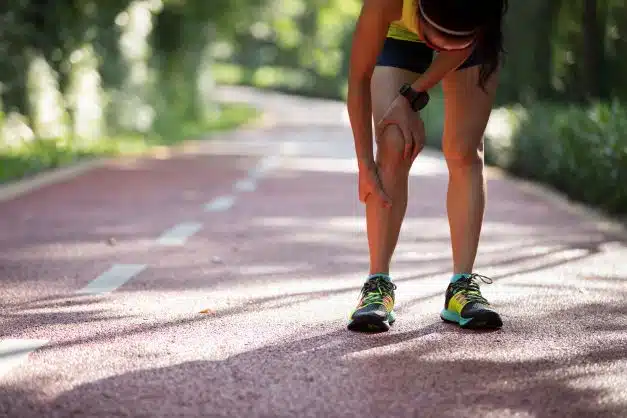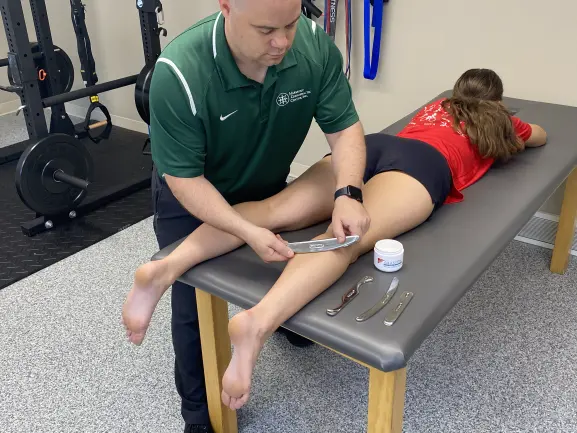Compartment syndrome is a painful condition. The muscles often begin to swell due to trauma. And if patients allow the swelling to continue, it can cause enough pressure to create nerve and muscle damage. Sometimes even resulting in disability in the affected muscles.
Anyone can have this condition, but, most of those who struggle with it are people who do repetitive motion exercises. Like running, swimming, and weight lifting. Research shows that acute compartment syndrome is more common in men than in women.
The incidence rate is estimated to be 0.7 per 100,000 in women and 7.3 per 100,000 in men1, with most cases happening after blunt trauma. Here is a quick look at what compartment syndrome is all about.
This condition happens when pressure builds up within a compartment to dangerously high levels. This pressure hinders circulation to the lower leg, which could damage the nearby nerves and muscles. This health issue can be either chronic or acute.
- Chronic – Chronic cases induce cramping and pain in the lower leg every time you exercise. It occurs gradually and should subside when you stop exercising. This is typically what athletes like a runner or triathlete can get.
- Acute – Acute cases2 often experience severe pain in the lower leg when they stretch the muscle within the compartment. It occurs suddenly and needs urgent medical treatment.
What Causes Compartment Syndrome?
The lower leg is the area between your knee and ankle and is separated into different areas or compartments – anterior, lateral, superficial and deep posterior. The anterior compartment is at the front of the leg, located to the outside area of the shin bone and mostly associated with the tibialis anterior muscle, which dorsiflexes the ankle. The lateral compartment is located on the outside of the leg and is responsible mostly for everting the foot due to the action of the fibularis muscles (Anatomy nerds would be interested in the fact that many still call this area the peroneus muscles). The superficial posterior compartment points the toes and is composed of the muscles that most people consider to be the calf (gastrocnemius and soleus muscles). The deep posterior compartment is often more associated with a small area medial to the shin and is responsible for inverting the foot and flexing the toes.

Each compartment is innervated by a different nerve and has an enclosed area surrounded by a thick layer of fascia. There is not much room for the involved musculature to swell so instead of swelling the pressure increases. Nerves are typically the most vulnerable to compression and can suffer permanent damage in certain circumstances.
Acute compartment syndrome in the legs is often caused by physical trauma or broken bone. In fact, 75% of these cases occur due to a broken bone. It can also happen from burns, applying a super tight bandage or plaster cast before the leg has stopped swelling. Surgery to fix a blocked or damaged vessel can also be an underlying cause. In some rare cases, this health problem can occur without an apparent injury.
The chronic version of compartment syndrome can happen in younger people who do repetitive, regular, and vigorous physical activity. Such as cycling or running. Some experts3 suggest that when the muscles temporarily swell during physical activity, they can affect circulation. This temporary swelling might be the source of the problem, but the exact cause remains unknown.
Compartment Syndrome Symptoms
Acute compartment syndrome tends to develop after injuring the leg. Some of these symptoms can include:
- Pain when poking the involved muscle
- Pain when stretching the involved muscle group
- Bruising
- Tightness
- Swelling
- Numbness
- Persistent deep pain
- Pins-and-needles sensations
- Muscle Weakness
Symptoms of exertional compartment syndrome include worsening cramps or pains in the lower leg. You might experience tension or a muscle bulge in the affected area. The symptoms can happen shortly after starting the workout. With adequate rest, the aches and discomfort should subside.

How Is Compartment Syndrome Diagnosed?
First, the doctor can suggest imaging studies, such as MRI. MRI can scan the legs and see if the structure of the muscles in the compartments is affected in any way. If there has been a stress fracture, the scan will show what’s causing the symptoms.
The MRI can analyze4 the fluid volume of the compartments and detect any abnormalities that might lead to exertional compartment syndrome. The doctor might suggest NIRS (near-infrared spectroscopy) if they have to check the amount of oxygen in the damaged tissue. This can identify whether there is reduced circulation to the affected area.
When more results are necessary for a proper diagnosis, doctors can suggest compartment pressure testing. It can help assess the pressure within each muscle compartment. It is a practical choice for diagnosing chronic compartment syndrome. This invasive testing method can hurt.
Compartment Syndrome vs Shin Splints
For many people with chronic compartment syndrome, the condition can feel like shin splints. The main difference between compartment syndrome vs shin splints is where you experience the pain.
- The pain from compartment syndrome is often focused on the outside front of the leg.
- Shin splints cause pain on the inner side of the leg.
The pain from compartment syndrome feels like an increasing and intense pressure building up in the muscle groups. The legs might feel full or swollen. With shin splints, there is tenderness and pain on the inside front of the shin (lower leg). It is most common for compartment syndrome to occur in the lateral compartment and the anterior compartment

One sign that you are having chronic compartment syndrome is that the pain dissipates when you stop the activity. If there is still some weakness or numbness, these should resolve relatively fast. The pain from shin splints often lasts for an extended period of time during rest.
During a physical exam5, the affected area from exercise-induced compartment syndrome often feels normal, without tenderness to palpation. Whereas those with shin splints tend to experience tenderness over the fascia or bone.
Why Is Compartment Syndrome Dangerous?
When pressure increases, oxygenation decreases, and waste products start to accumulate. Without restoring blood flow, the tissues, muscles, and nerves can’t function properly. This is causing discomfort and pain. Lack of treatment can cause potentially serious damage to the muscles, possibly even necrosis. Necrosis is the death of body tissue. When needed in acute situations, surgery can prevent lasting nerve damage.
Treatment for Compartment Syndrome
Treatments can help decrease pressure and ease discomfort. These can include surgical intervention, medications and conservative treatments. Medications typically involve over-the-counter nonsteroidal anti-inflammatory drugs (NSAIDs), but Botox can be another option
Fasciotomy – A Surgical Solution
Fasciotomy is a surgical procedure for relieving pressure in the muscle compartments and treating patients with chronic/acute compartment syndrome. The surgery can take anywhere from 30 min to 2 hours or more. Surgery is not typically one of the first things that I would recommend but it definitely depends on the situation. Acute cases of compartment syndrome do warrant a fasciotomy and delaying more than three hours can result in nerve damage.
Conservative Treatment
Chronic exertional compartment syndrome normally has options to decrease its occurrence. Compression is not a good thing in compartment syndrome so compression tights and Ace wraps need to be loosened. Elevation of the extremity up to the level of the heart can increase drainage and decrease swelling.
Activity modification is often needed with decreased distance or intensity Alternatively, one may need to work on their pacing. For those that want to retain their aerobic conditioning, cycling can often be substituted for running. In some cases, it might be necessary to avoid the offending activities. Decreasing stride length may also be an option.
Some individuals who have mild symptoms tend to benefit from massage therapy. Massage therapy can also be beneficial to some who have declined surgery. Manual therapy and treatments like Graston Technique can also be beneficial. Compartment syndrome has been linked with abnormal foot biomechanics like overpronation so custom foot orthotics can be of benefit. Changing to softer training surfaces can also be helpful.

Corrective exercises can be helpful as improved range of motion and muscle strengthening can be beneficial. Joints that have an impaired range of motion can benefit from chiropractic manipulation or joint mobilization.
References
- Allison M. Torlincasi. Acute Compartment Syndrome. National Library of Medicine. https://www.ncbi.nlm.nih.gov/books/NBK448124/. Published August 7, 2022.
- Jocelyn Ross Witstein. Compartment Syndrome. American Academy of Orthopaedic Surgeons. https://orthoinfo.aaos.org/en/diseases–conditions/compartment-syndrome/. Published May 2022
- National Health Service. Compartment syndrome. https://www.nhs.uk/conditions/compartment-syndrome/. Published 17 September 2019
- Mayo Clinic. Chronic exertional compartment syndrome. https://www.mayoclinic.org/diseases-conditions/chronic-exertional-compartment-syndrome/diagnosis-treatment/drc-20350835. Published Oct. 21, 2022
- David Grauer. Shin Splints, Compartment Syndrome. How to Tell the Difference. Boulder Medical Center. https://www.bouldermedicalcenter.com/exercise-induced-compartment-syndrome/. Published 2022
